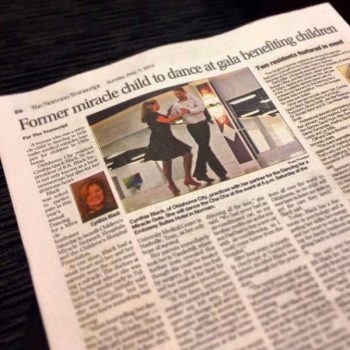Know your audience — The Press
 “Know your audience.” It’s our mantra as communicators and marketers. It guides us as we craft our messages, our marketing campaigns and our promotional efforts.
“Know your audience.” It’s our mantra as communicators and marketers. It guides us as we craft our messages, our marketing campaigns and our promotional efforts.
But do we follow this guideline when writing press releases?
Sure, we write using the inverted pyramid construction, employing AP Style and giving the who, what, when, where and why — just like we learned in school or perhaps on the job. But do we really consider our audience, as in, the press?
According to the Bureau of Labor Statistics, newspaper publishers lost more than half their employment from January 2001 to September 2016.
This downward trend is not for newspapers only, but it is expected across the board for those working in the news media. In fact, BLS projects the overall employment of reporters, correspondents and broadcast news analysts to decline by nine percent from 2016 to 2026.
What does this mean for us as communicators? It means our audience, the press, is understaffed and overworked and will likely only become more so in the near future.
Now, knowing this about your audience, here are four things you can do to increase the likelihood your press release will get attention and your message picked up by the press.
Write your press release as a news article
You’ll never see a news release, at least one written as you were taught in J or PR school, printed in a newspaper. Why? Because a traditional news release written with AP Style and the inverted pyramid may be proper, it’s not ready for print. It doesn’t have a snappy lead and it’s heavily weighted with boring branding information.
So why not save the news and editorial staff some time and write a print-ready article? That way, if they are pressed for time and they like your material, it’s really easy to place your copy on a page. If they like your story and they do have time, they may tweak it a little, call you for more information or even reach out to arrange an interview.
But remember your goal is to get your news in the press. The less work the editor has to do to get it there, the more likely he or she will include it. You may not get an interview, but you’ve got press. Oh, and for Pete’s sake … please use AP Style!
Send photos
When sending a press release, send photos. Again, newsrooms are short-staffed. The editor may like your news release, but the newspaper may only have a few photographers, and they may be out on other stories. The editor is pressed for time and rather than calling you to ask for one to run with the story, he or she may opt for another news release already with a photograph. Increase your chances of getting some press by making the editor’s job easier and sending a photo or two with your story.
Match your writing to your targeted media
Write your news release to fit the media genre you are targeting. Up to this point, we’ve talked largely about sending news releases to newspapers, but there’s broadcast and internet-based news, too. Broadcast news is written in shorter, snappier bits and so is most internet-based news. This latter form even tends to be a bit more informal than what you find in print. So when you are writing, consider the kind of press you are sending it to. If you’re sending it to a newspaper, a longer, more detailed article with a higher vocabulary is fine. But if for broadcast or online media, you might consider tightening up your copy, lightening it and simplifying it. Again, you want to create less work for the member of the press looking at your article.
Send video
Broadcast, online and even print-based news media are using video more and more. So when sending your article, send it not only with photos, but also with video, enough so your target news staff will be able to edit it to fit their need, whether for broadcast or online. If “spraying b-roll,” shoot some wide shots and tight shots pertaining to your subject. If shooting an interview, make sure your lighting and audio is good, and that it includes some good sound bites supporting you message. If you want to see what your video should look like, next time you watch your local news, watch for the b-roll used for voice-overs, camera angles and framing. Imitate that.
In summary, if you want your news in the news, give the news everything they need to make their jobs as easy as possible. Doing so may increase your chances your news will get press.
Want proof this works? I used the above method as the communications coordinator for R.K. Black, Inc. and landed our vice president, Cynthia Black, in two papers. The Norman Transcript used my story as I wrote it and used my photo and the OKC Friday arranged for an interview.
Sources:
- https://www.bls.gov/opub/ted/2017/newspaper-publishers-lose-over-half-their-employment-from-january-2001-to-september-2016.htm
- https://www.bls.gov/ooh/media-and-communication/reporters-correspondents-and-broadcast-news-analysts.htm#tab-6

Thomas Berger is a communications and digital marketing specialist. Prior to striking out on his own, he was the communications coordinator at R.K. Black, Inc., an Oklahoma City-based technology company, where for more than four years he was been a one-man team of digital marketing, internal and external communications and social media specialists.
Prior to R.K. Black, he worked for ten years as a journalist, starting out as a staff writer for two newspapers in North Carolina, then working for three papers in northeastern Oklahoma and finally finishing his journalism career as a multimedia journalist for KJRH Channel 2 in Tulsa. There he reported for and ran a hyper-local news website, BartlesvilleLIVE.com, before being transferred to covering news in Tulsa’s surrounding areas for the television station’s online “Community” news section.
Born in the Netherlands and having lived in multiple countries and a number of states, Thomas moved from North Carolina to Oklahoma eight years ago, where he met his wife and now lives in her hometown of Edmond. He holds a Bachelor of Arts in English with a journalism concentration from Western Carolina University where he also minored in photography. He currently serves on the board of the International Association of Business Communicators (IABC) Central Oklahoma chapter as the VP Professional Development after serving for two years as the VP Communications.
In his spare time, Thomas enjoys photography, writing, hiking, backpacking, camping, traveling, learning languages, gardening and being a handyman.